All Materials © Cmassengale |
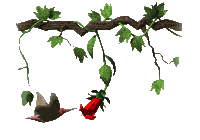 |
PLANT LIFE CYCLES:
- A life cycle includes all of the stages of an organism’s growth and development
- A plant’s life cycle involves two alternating multicellular stages – a Diploid (2n) sporophyte stage and a Haploid (1n) gametophyte stage
- This type of life cycle is called Alternation of Generations
Moss Characteristics:
- Nonvascular (pass water cell-to-cell)
- Seedless (reproduce by spores)
- Low growing
- Phylum Bryophyta (also includes liverworts & hornworts)
- Grow on moist brick walls, in sidewalks, as thick mats on forest floors, and on the shaded side of trees
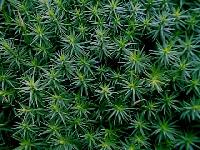
- Can survive periodic dry spells, reviving when water becomes available
- Require water for fertilization so sperm can swim to egg
- Rhizoids (root like structures) anchor mosses
- Have waxy covering called cuticle on aerial parts to prevent desiccation
Moss Life Cycle:
- Dominant form of a moss is a clump of leafy green gametophytes (photosynthetic)
- Moss alternates between a haploid (1n) gametophyte and diploid (2n) sporophyte
- Gametophyte generation produces gametes (eggs & Sperm)
- Sporophyte generation forms at the top of the gametophytes and produces spores
- Stalk-like sporophytes lack chlorophyll
- Capsule at the top of the sporophyte forms haploid (1n) spores

Sexual reproduction in Moss:
- Moss produce 2 kinds of jacketed gametes — eggs & sperm
- Egg producing organ is called the archegonium
- Eggs are larger and nonmotile
- Sperm producing organ is called the antheridium
- Sperm are smaller, flagellated cells
- Antheridia & archegonia are both part of the gametophyte plant
- Fertilization can occur only during or soon after RAIN when the gametophyte is covered with Water
- Sperm swim to the egg by following a trail of chemicals released by the egg in the water
- Fertilization produces a zygote that becomes a sporophyte
- Mature sporophytes produce homosporous spores (all the same type)
- Mature capsules open & release spores spread by wind
- Spores landing on moist places germinate into protonema that become new gametophytes
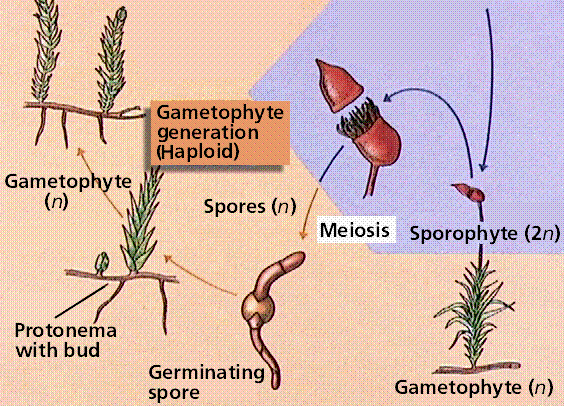
Asexual Moss Reproduction:
- Small pieces may break off from a gametophyte & become a new plant (fragmentation)
- Small buds called gemmae may be washed off by rain and develop new moss plants
 Fern Characteristics & Life Cycle:
Fern Characteristics & Life Cycle:
- Largest group of seedless, vascular plants
- Grow in moist places
- Goes through alternation of generations
- Sporophyte phase is the dominant stage
- Fern gametophytes are small, flat plants anchored to the soil by root-like rhizoids
- Antheridia & archegonia form on the underside of fern gametophytes
- Sperm swim to egg through water droplets to form zygote (fertilized egg)
- Zygotes form new sporophytes with roots, stems, & leaves
- Spore cases called sori form on the underside of fern fronds (leaves)

- Ferns are homosporous (single type of spore formed)
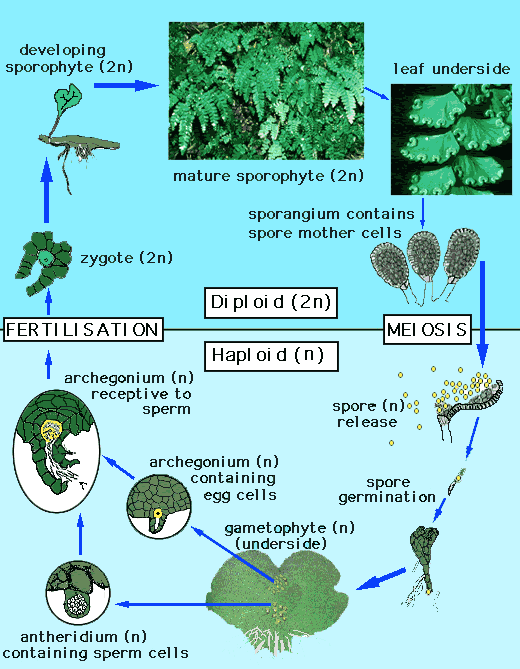
- New fronds form from an underground stem called the rhizome
- Vascular tissue carries nutrients & water between the parts of the fern
- Fronds are compound leaves attached by a short stalk called the stipe to the underground stem or rhizome

- Immature fronds or fiddleheads are coiled

 Characteristics & Life Cycle of Conifers:
Characteristics & Life Cycle of Conifers:
- Called gymnosperms
- Have naked seeds that develop on scales of the female cones
- Sporophyte is the dominant stage
- Adapted to cooler climates
- Called evergreens (pine, cedar, spruce, fir…)
- Giant Redwood is one of the Earth’s largest organisms
- Bristlecone Pines are the oldest living organisms (some more than 5000 years old)
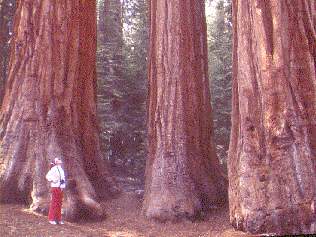 |
 |
| Giant Redwood | Bristlecone Pine |
- Produce 2 types of spores (heterosporous)
- Male spores called microspores grow into male gametophytes
- Female spores called megaspores grow into female gametophytes
- A Pine cone is the female cone on a pine tree
- Male cones on pine trees are smaller & grow in clusters at the tips of branches
- Both male & female cones appear on the same tree
 |
 |
| Female Cones | Male Cones |
- The pine life cycle takes 2-3 years from the formation of cones until seeds are released
- Female cones have spirally-arranged scales with ovules at their base
- Female cones produce sticky resin
- Ovules contain an egg that will develop into a seed
- Male cones produce large amounts of pollen in the spring that is spread by wind to the female cones
- Resin traps the pollen so pollination can occur
- A tube from the pollen grain takes a year to grow to the ovule so a sperm can fertilize the egg and form seeds
Angiosperms or Flowering Plants:
- Bright colors, attractive shapes, and fragrant aromas help flowering plants attract their pollinators (insects, birds, mammals…)
- Flowers without bright colors and pleasing odors are usually wind or water pollinated (grasses)
- Called angiosperms
- Flowers, the reproductive part of a plant, have a swollen base or receptacle to attach to the stem
- Flowers have 4 whorls (modified leaves) attached to the receptacle — petals, sepals, pistils, and stamen
- Pistils (innermost whorl) are the female part of the flower, while Stamens are the male part
- Sepals (outermost whorl) are found below the petals and may look leaf-like (some may be the same color as petals)
- Sepals enclose the flower bud before it opens
- Sepals are collectively called the calyx
- Petals are often colorful to attract pollinators
- Petals are collectively called the corolla
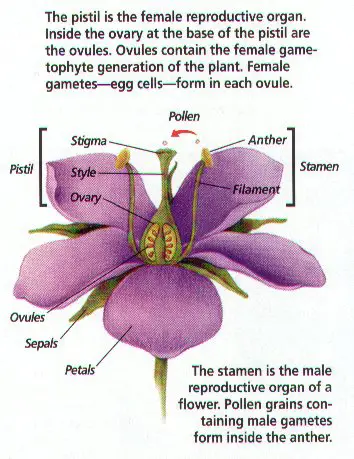
- Monocot flower parts are arranged in multiple of THREES, while dicots are in multiples of FOUR or FIVE
- Perfect flowers have both stamens & pistils (rose)
- Imperfect flowers are either a male (pistillate) or female (staminate) flower (pumpkin or melons)
- Some angiosperms have both male & female flowers on the SAME plant (monoecious)
- Other angiosperms have entire male OR female plants (dioecious)
Female Reproductive Structures:
- Called carpals
- Carpals may be fused to form the pistil
- Produce eggs
- Composed of 3 parts — stigma, style, and ovary
- Stigma is located at the top and may be sticky or have hairs to hold pollen grains landing there
- Style is a stalk-like connection between the stigma and the ovary
- Ovary is the enlarged base containing ovules with eggs

Pistil
Male Reproductive organs:
- Called stamens
- Produce pollen
- Composed of 2 parts — filament & anther (pollen sac)
- Anthers produce pollen grains containing sperm
- Filament is stalk-like & supports the pollen sacs

Stamen
Angiosperm Life Cycle:
- Undergo alternation of generations
- Sporophyte is dominant phase
- Gametophytes (flowers) form male & female gametes
- Anthers form pollen grains from microspores
- Pollen grains contain 2 cells — tube cell & generative cell (sperm)
- Two protective layers called integuments surround the megasporangium
- The entire structure including the integuments is the ovule and becomes the seed
- Each ovule has 4 megaspores (three disintegrate)
- The remaining megaspore undergoes mitosis to produce a large cell & polar nuclei
- When pollen lands on the stigma, a pollen tube grows through the style to the ovary
- Two sperm travel down the pollen tube — one fertilizes the egg and the other join with polar nuclei to form endosperm (stored food for Seed)
- Called Double Fertilization
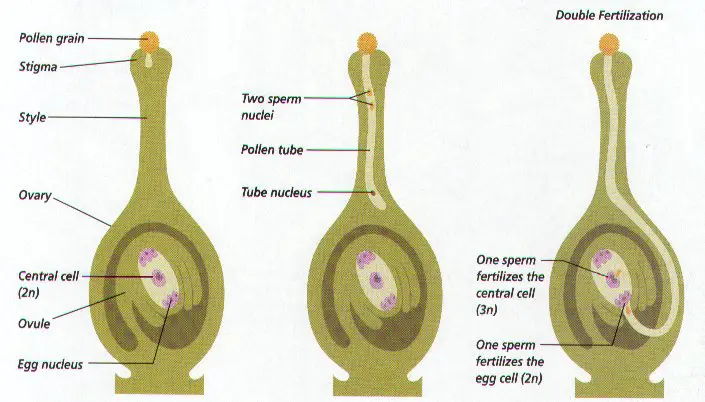
- After fertilization, ovule becomes the seed and the ovary & surrounding tissues form a protective fruit
- A fruit is a ripened ovary with seeds (apple, melon, cocklebur…)
- When seed land on moist soil, they germinate (sprout) and form new sporophyte plants
Pollination:
- Wind, water, and animals help spread pollen
- As pollinators drink nectar or eat the fruit, pollen gets on their bodies and is spread to other flowers
- Self pollination occurs whenever pollen from a flower lands on the stigma of that SAME flower (pea plants)
- Cross pollination occurs whenever pollen is spread to a different flower producing hybrids (more gene combinations)
Seeds & Fruit:
- Fruits are adaptations for dispersing seeds (coconuts float, cockleburs catch onto animal fur, some seeds eaten by birds aren’t digestible…)
- More energy is required to produce seeds than spores because they contain stored food
- Seeds may be dormant (inactive) for weeks or years protected by their seed coat
- Seeds contain a plant embryo and endosperm

- Many fruits are fleshy & their seeds aren’t digested by the animals that eat them
- Heavy seeds have adaptations such as wing-like structures (maple) or prickly coats (cocklebur) to help them disperse
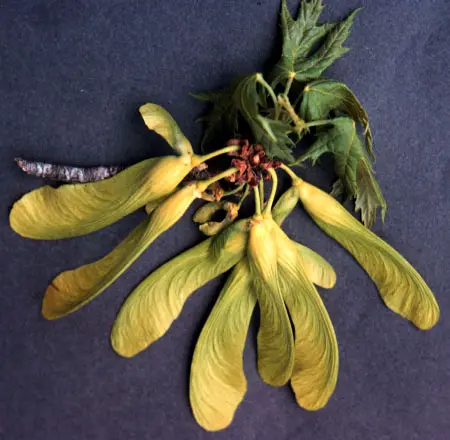 |
 |
 |
| maple seeds | Cockleburs | Coconut |
- Fruits may be dry or fleshy
- Three types of fruits exist — simple, aggregate, & multiple
- Simple fruits (apple) form from One pistil on a flower
- Aggregate fruits (raspberry) form from several pistils on a flower
- Multiple fruits (pineapple) form several flowers growing close together
- Cotyledons are leaf-like structures of the plant embryo
- Monocot seeds have one seed leaf (Cotyledon), while dicots have two cotyledons
 |
 |
- The epicotyl is the part of the plant embryo ABOVE the cotyledon & becomes the stem
- The radicle is the part of the plant embryo BELOW the cotyledon & becomes the root
- The hypocotyl is the part of the plant embryo BETWEEN the cotyledon & the radicle
- The hilium is a scar along the seed edge where it was attached to the ovary
- In monocot seeds like corn, a sheath called the coleoptile grows out of the ground to protect the newly emerging plant
Germination:
- Many seeds require environmental factors, such as Water, Oxygen, and Temperature to trigger germination
- Some seeds only germinate after exposure to extreme cold or after passing through an animal’s digestive tract
- Water must FIRST be absorbed by the seed to break the seed coat & activate enzymes to change starch in the endosperm or cotyledons into simple sugars for energy
- The radicle emerges first

- Once the seed coat opens, OXYGEN is needed for cellular respiration carried on by the embryo plant
- The shoot (hypocotyl & embryonic leaves) begin to grow, synthesize chlorophyll, and carry on photosynthesis
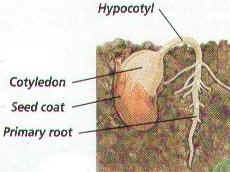
- After the stored food is used up in dicots, the cotyledons fall off
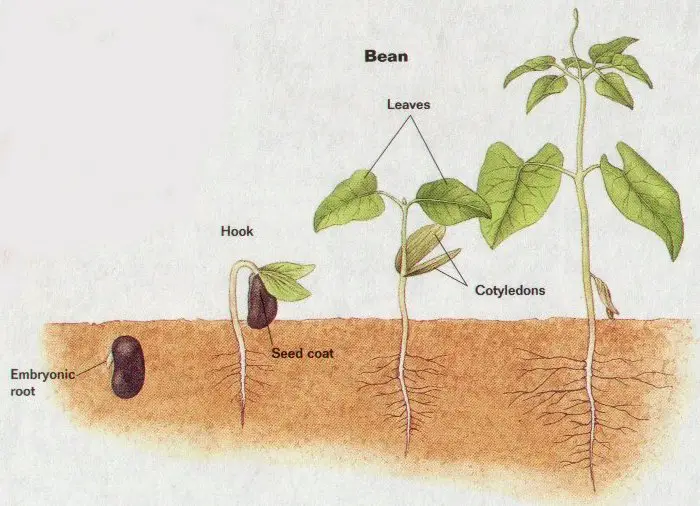
Dicot Seed Germination
- In Monocots like corn, the Cotyledon remains underground and transfers nutrients to the growing Embryo.
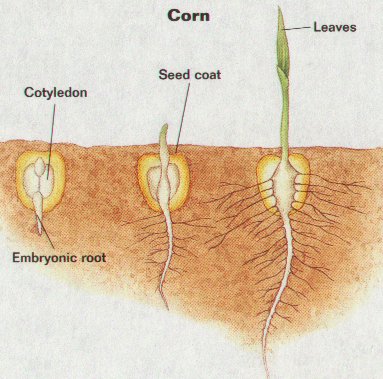
Asexual Reproduction in Plants:
- Asexual reproduction is FASTER and produces well-adapted offspring
- Called vegetative reproduction
- Occurs from non-reproductive parts such as roots, stem, or leaves
- Runners, Rhizomes, Bulbs, and Tubers can be used to produce new plants
- Cutting is taking a piece of Stem or Leaf and growing a new plant
- Grafting occurs whenever 2 cut ends of plant stems are fused
- Layering occurs when aerial roots touch soil & start growing new plants


